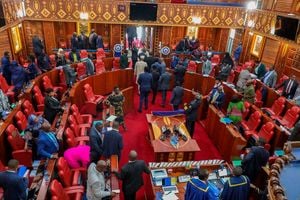
Maseno University Vice Chancellor Julius Nyabundi is mobbed by students during the first-years orientation at the institution on September 19, 2023.
| Ondari Ogega | Nation Media GroupEducation
Premium
New funding model turns into a windfall for private varsities
Private universities have reported a high demand for admissions as students shun public ones following the adoption of the new funding model that many perceive as expensive, especially because of the loan component.
The development is a huge relief for private universities that have experienced low admissions since 2016 and had to rely on the government to place and sponsor some students in the institutions.
Some in-demand programmes in private universities are reportedly full and prospective students have been asked to wait for the January intake.
A number of students who had been placed for courses in public universities have not reported, instead opting for private institutions where they believe they will get value for their money.
Students and parents who spoke to Nation gave various reasons for shunning public universities in favour of the private ones.
Mr Cyprian Mavindu said he was unimpressed when his son who was a student at Mang’u High School and scored a mean grade of B (plain) was placed to undertake Bachelor of Education in Early Childhood and Primary Education at Garissa University. He did not take up the offer and is now pursuing a computer science degree at Daystar University.
“He was placed for a programme he didn’t choose and in a university he didn’t choose. The notion that private universities are expensive has now been demystified. I made the decision also because of the time factor. Private universities have adopted the trimester way where students complete a four-year programme in three years,” he said.
Mr Mavindu said many parents have also been influenced by uncertainty surrounding the government funding. The applications window will close on October 7 and the results are expected one week later.
“You don’t want to waste time until you’re categorised based on need only to realise that you qualify for so little or nothing at all,” he said.
The funding model has split funding into scholarships and student loans. Students who enrol in public universities qualify for both but those who opt to study in private universities only qualify for the student loans.
Mount Kenya University Vice-Chancellor Deogratius Jaganyi said that they have surpassed their target of 7,000 students having admitted 7,874 first-year students in the first week.
“All the students at our university are now private-sponsored and we’re happy with the arrangement. Those coming to us come because of what we offer. Now we don’t have to rely on government funding,” Prof Jaganyi said.
Competitive
“There has been a perception about fees in private universities but we’re competitive and comparable with the fees in public universities,” he added.
Prof Jaganyi told the Nation that this year, the university has 2,300 students placed by the Kenya Universities and Colleges Central Placement Service (KUCCPS).
The founder of the university, Mr Simon Gicharu, said that the students placed by the government will pay for their education since they were placed without any conditions.
“We’ve gone back to the old system where students pay fees to us directly. For those who apply for loans, Helb (Higher Education Loans Board) is only a platform,” he said.
Zetech University VC Njenga Munene said that their first-year admissions have almost tripled, with about 1,600 students already admitted in the first week. He said the new funding model favours private universities since all students are self-sponsored and do not have to wait for the government grants.
“Parents have come to appreciate timely completion of our programmes. Students graduate after three calendar years and one semester; there’s predictability. It gives them a peace of mind which you can’t buy,” he said.
Prof Munene added that the requirement for all universities to declare the cost of their programmes had worked in favour of private universities.
“There’s nothing hidden from anyone about how much we charge and how it compares with other universities. It’s easy to plan and there’s no anxiety over categorisation based on need. No one knows about the second year and how much they’ll get. I advise parents to consider the cost of the programmes and how much liability their children will bear upon completion,” Prof Munene said, adding that the loan component for fees is likely to result in students graduating with huge loans.
“How does such a student even start life? It’s the American model which is very expensive,” he said.
Not affected
The VC of Strathmore University, Dr Vincent Ogutu, said that the university had not been affected since it never relied on government-sponsored students.
“We interview every single student ourselves before we admit them. Our funds come from charging fees, doing consultancy work and executive education, getting grants and doing a lot of fundraising,” he told the Nation.
His Daystar University counterpart Prof Laban Ayiro said that in the first week, the university had admitted about 1,400 students, way above the 800 admitted last year. The university has been allocated 430 students by KUCCPS. Prof Ayiro revealed that the law course had the most students yet it is one of the most expensive.
“We’ve never had such an intake since I came. The funding model is a gift for us because parents are coming knowing it’s about the loan and the household. We’re not getting the vulnerable group who’re fully sponsored. We’re getting those who the government will give loans and indeed they’re coming with a commitment letter. The challenge for us is now to up our game and quality,” Prof Ayiro said.
He said that the funding model might result in students completing studies with huge loans.
“Models can be nice but my fear is that we’re walking close to the American model and student loans are killing them,” he said.





